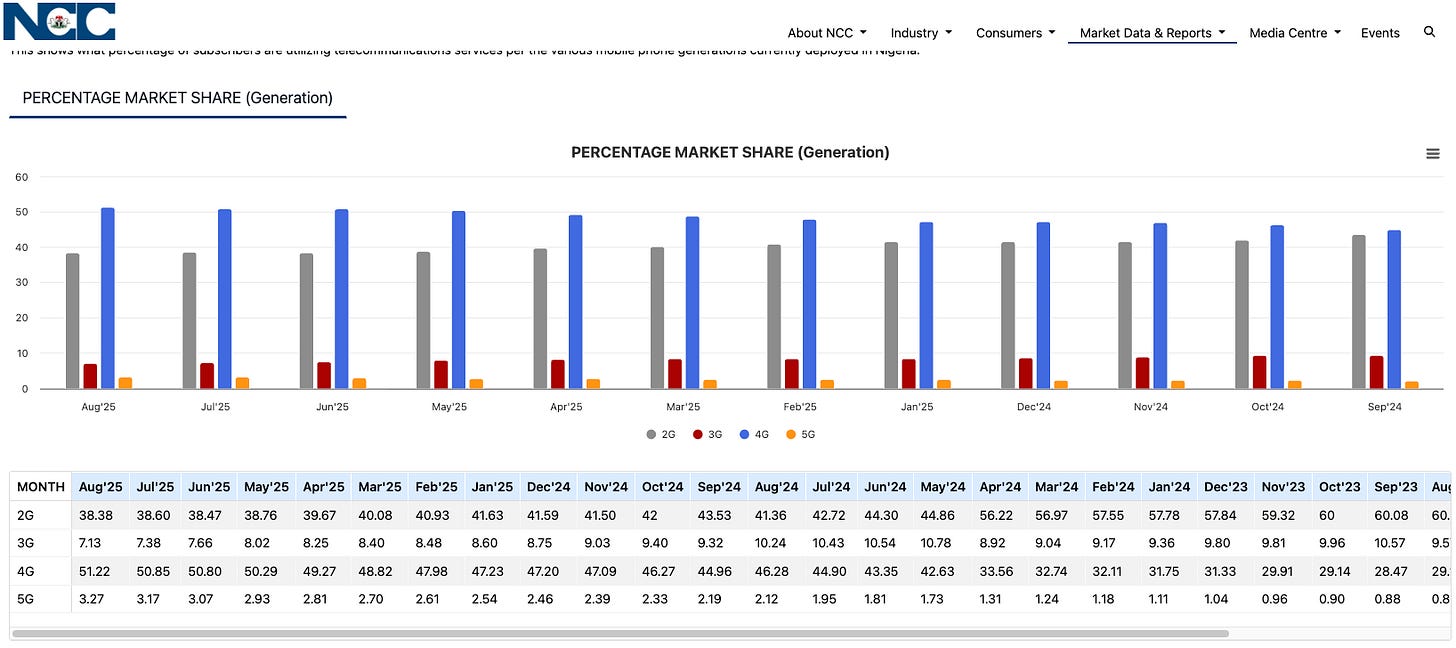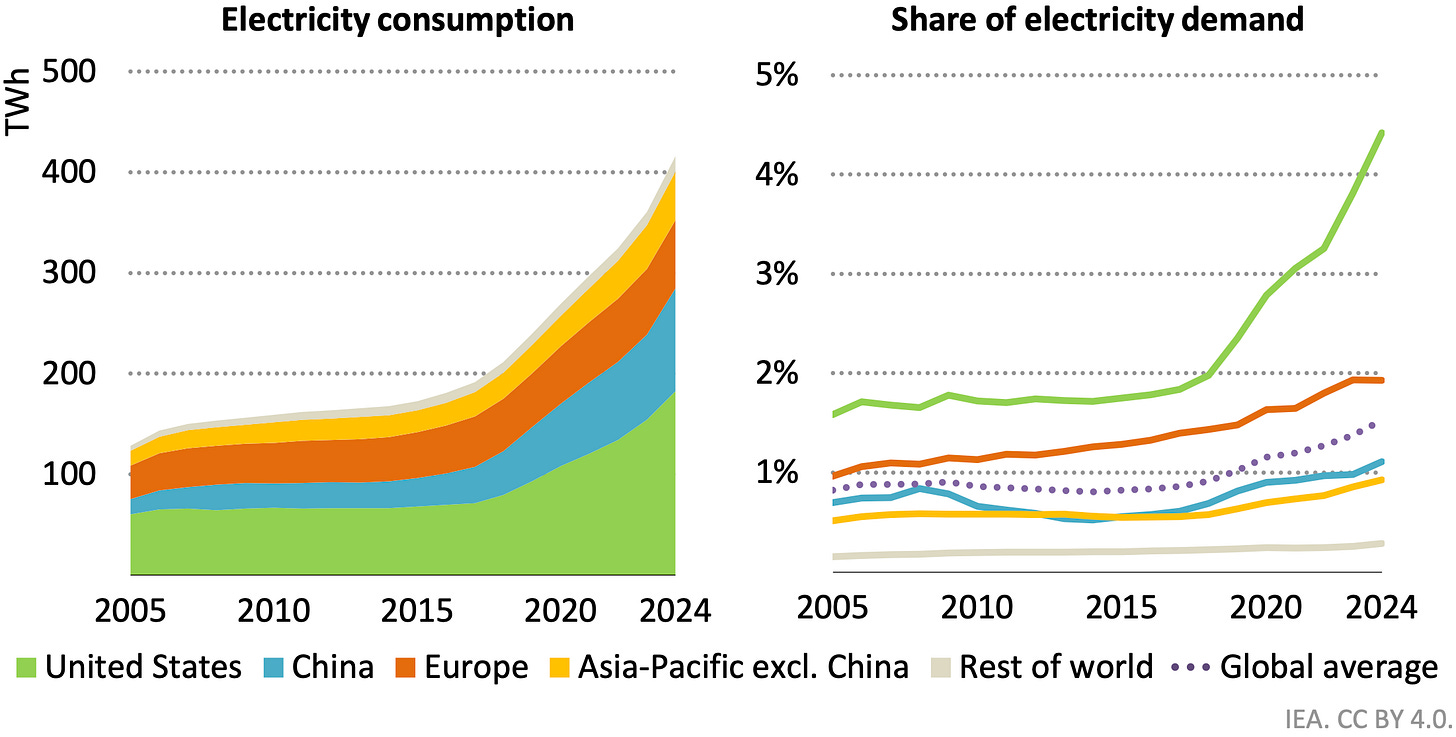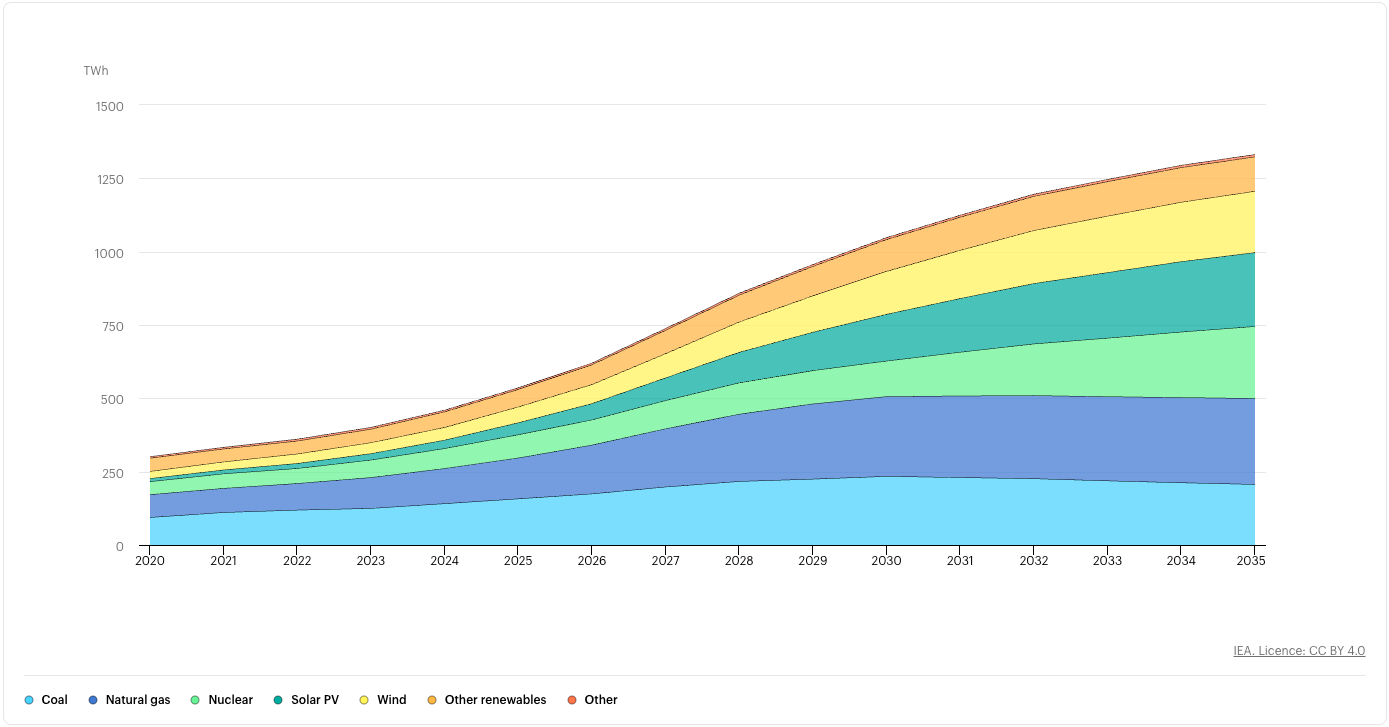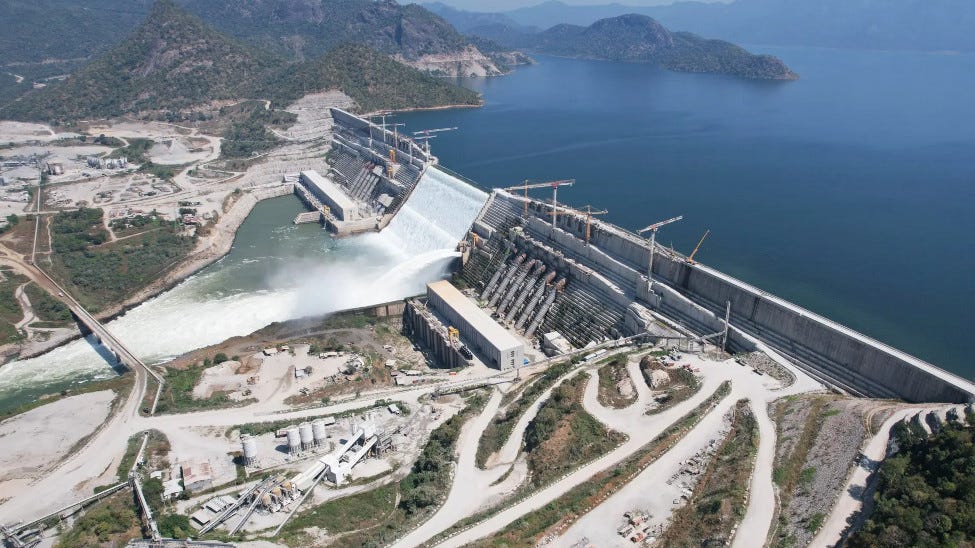Why Africa Doesn’t Need Nuclear Power for AI (Probably)
A Response to MTN Nigeria's Nuclear Vision as reported by Tech Cabal
First, The Disclaimers
Look, I need to be honest with you. I’m writing this response to a techcabal article from three weeks ago, about a talk I didn’t attend, given by Karl Toriola (MTN Nigeria CEO), transcribed by someone at TechCabal who may or may not have been checking Twitter during the important bits (Hi Frank Eleanya). So I’m basically three degrees of separation from the actual argument, which in academic terms makes this “speculative fiction.” There’s probably nuance lost, context missing, and emphasis shifted.
This is essentially a game of infrastructure telephone played through journalism, which makes me exactly qualified to have opinions about it on the internet.
But you know what? Sometimes distance gives you clarity. Like how you need to stand back from a Jackson Pollock painting to realize it’s not random splatters but actually... wait, no, it’s random splatters. Bad example.

With those caveats in mind, let’s talk about why the nuclear-for-AI narrative—at least as reported—might be solving the wrong problem with the wrong technology at the wrong time. Or maybe not. We’ll see where the math takes us.
The Problem
This is the part Where Karl Makes Perfect Sense. Let’s start with the numbers:
Global AI Infrastructure Context:
Data centers consumed ~415 TWh globally in 2024 (about 1.5% of global electricity)
US: 45% of this consumption
China: 25%
Europe: 15%
Africa: <1% (we’re literally a rounding error)
Toriola isn’t wrong about the problem. Nigeria’s grid delivers somewhere between 5,300 and 7,600 MW, depending on whether the grid woke up on the right side of the bed. MTN’s shiny new Sifiso Dabengwa Data Centre in Lagos? Starting at 4.5 MW. Scaling to maybe 20 MW if everything goes perfectly.
Cute.
Microsoft’s newest data center in Mount Pleasant, Wisconsin? 400 MW.
That’s not a typo. That’s not a different unit of measurement. That’s just what happens when you decide to teach sand to think. It gets HUNGRY.
Training GPT-4 consumed about 50 gigawatt-hours of electricity. You know what that means in Nigerian terms? That’s enough electricity to power 21,000 homes for a year. For one model. Trained once. Except they didn’t train it once. They probably trained it 50+ times with different parameters, which means we’re talking about 500 GWh before anyone even got to ask ChatGPT to write their resignation letter.
So yeah, when your entire national grid could maybe power 15-30 modern AI data centers on a good day, nuclear starts to sound reasonable. One small modular reactor could deliver 50-300 MW of beautiful, consistent, atom-splitting power. No sun required. No wind needed. Just good old-fashioned nuclear fission, like God and Oppenheimer intended.

The Nuclear Fantasy
Now here’s where I ruin everything.
Here are the five reasons nuclear won’t work for AI in Africa yet;
1. SMRs are still theoretical
Small modular reactors, SMRs, are the nuclear industry’s equivalent of “my girlfriend who goes to another school.” Everyone talks about them, nobody’s actually seen one working, but they definitely, absolutely, 100% exist and are amazing.
Even TechCabal notes no data centre runs directly/baseloaded on nuclear yet; the action is mostly MOUs and forward PPAs (Equinix, Standard Power), with SMR firsts ‘expected’ around 2030. If you don’t speak nuclear-industrial complex, let me translate: “2030” means “2035 if we’re lucky, 2040 if we’re honest, and actually never but we need the funding to continue.”
NuScale, the most advanced SMR company, the one everyone points to as proof that SMRs are real, in 2023 canceled their flagship project in Idaho.
Why? Cost overruns.
It was supposed to cost $3.6 billion for 462 MW. It ended up at $9.3 billion for the same output. That’s $20,000 per kilowatt, which makes gold-plated solar panels look economical.
But wait, it gets better!
Egypt’s El Dabaa project, the crown jewel of African nuclear ambition, was announced in 2015. Construction started in 2022. It might produce power in 2030. That’s 15 years from “we should do this” to “electricity comes out,” and Egypt actually has nuclear expertise and the full backing of Russia.
Nigeria? Ghana? Kenya? They’re “still building regulatory capacity,” which is the diplomatic way of saying “we have three guys who once watched a YouTube video about atoms.”
2. oh, there is the “Water Thing”
You want to know a fun fact that somehow didn’t make it into any of the nuclear-for-Africa presentations?
Nuclear plants need water. Lots of water. Obscene amounts of water.
We’re talking 2,725 liters of water for every megawatt-hour generated. A 1 GW nuclear plant needs 65 million liters of water. Per day. Every day. Forever. That’s just for cooling the reactor, not including the data center itself, which needs another 1.8 liters per kilowatt-hour of IT load.
So let me get this straight. The proposal is to build the most water-intensive form of power generation to supply water-intensive computing facilities... in Africa? The continent where water scarcity is already a crisis? Where Lagos literally floods in rainy season and rations water in dry season?
The same Lagos that can’t provide consistent water to humans is supposed to dedicate 70 million liters per day to cooling nuclear reactors so we can ask ChatGPT to write our emails?
This is peak humanity. This is us.
3. The Timeline Argument
Hybrid renewable system deployment takes 3 months for site selection, 6 months for environmental permits, and 12-18 months for construction. Total: 2 years to operational.
Nuclear timeline, being generous, requires 10 years for regulatory framework, 5 years for site selection and approval, and minimum 7 years for construction. Total: 22 years if everything goes perfectly.
By the time your nuclear plant is operational, we’ll have built 11 generations of renewable projects, trained AI models we can’t even imagine, and probably discovered fusion. (Kidding, fusion is always 20 years away.)
Translation: By the time any new African nuclear plant comes online (optimistically 2040), the AI compute landscape will be unrecognizable. We’d be building telegraph poles in the age of satellites.
4. the fun Geopolitics
Every nuclear reactor is a geopolitical relationship status update.
Russian VVER reactors? Congratulations, Putin now has opinions about your data sovereignty.
American AP1000s? Welcome to becoming a line item in State Department briefings forever.
Chinese Hualong One reactors? Hope you’re comfortable with technical advisors who mysteriously need access to everything and never quite leave.
Meanwhile, solar panels are the commodity of commodities. They’re so commoditized that the main complaint is they’re TOO cheap and destroying profit margins. You can buy them from dozens of suppliers, none of whom will later claim your data center is strategically important to their national interests. And finance them through normal commercial channels, and maintain them with local expertise. No uranium supply chains, no proliferation concerns, no 123 Agreements with nuclear powers.
5. The Required Human Capital
Here’s a partial list of expertise needed to run a nuclear program:
Nuclear engineers
Health physicists
Radiation safety officers
Nuclear regulatory lawyers
Waste management specialists
Security forces trained in nuclear facility protection
Emergency response teams for nuclear incidents
Here’s what you need for solar:
Electrical engineers (Africa has thousands)
The guys who already maintain telecom backup power
Someone who can read an instruction manual
6-month training programs for most roles
Nigeria is supposedly going to create an entire nuclear regulatory framework, train a nuclear workforce, and build nuclear plants faster than it took to... checks notes... get 4G coverage to most of Lagos?
okay….

What’s Actually Powering Real Data Centers
Google’s Data Centers: Oklahoma: 48 MW wind power purchase agreement. Chile: 80 MW solar farm dedicated to their facility. Denmark: 160 MW of offshore wind. Finland: Runs on hydroelectric and wind, carbon-neutral since 2017.
Microsoft’s Actual Portfolio: Sweden has three facilities running on 100% hydropower. Ireland just signed 170 MW wind PPA, not nuclear. Wyoming combines 237 MW wind with 10 MW battery storage. Virginia just contracted for 250 MW of solar plus storage.
Amazon Web Services Reality: Oregon runs 100% on hydro from the Columbia River. Ireland built a 110 MW wind farm in County Cork. Australia operates a 60 MW solar farm in Queensland. Globally, they’re at 85% renewable energy across all facilities as of 2024.
Notice what’s missing? Nuclear. Not a single operational hyperscale data center is powered primarily by nuclear today. The ones talking about it are talking about 2030+.
The Renewable Solution
Hybrid renewable systems are crushing it right now. Not in 2030. Right now.
Kenya’s Konza Data Center: Running on 90% geothermal plus 10% solar. Operational. Today. Not a rendering.
Morocco’s Green Energy Park: Combines 20 MW solar PV, 5 MW wind, and biomass backup from agricultural waste. Powers their entire tech hub in Ben Guerir. It exists. You can visit it.
Rwanda’s Innovation City: Powered by methane from Lake Kivu (yes, the lake that could explode) plus solar plus micro-hydro. They’re literally turning a geological time bomb into data center power. If that’s not African innovation, I don’t know what is.
South Africa’s Teraco: Running Africa’s largest data center network on solar (120 MW installed), wind (contracted 80 MW), wheeled hydropower from Mozambique, and battery storage that’s cheaper than you think. Now under $150/kWh.
And hey, there is Bioenergy too
Africa produces 650 million tons of agricultural waste annually. Nigeria alone generates 100 million tons of cassava peels, rice husks, palm kernel shells. Each ton of agricultural waste can generate 1-2 MWh through gasification. That’s 100-200 TWh of potential energy literally rotting in fields.
Uganda’s Kakira Cogeneration: 52 MW from sugarcane bagasse. Sells excess to the grid. Has been operational since 2007. Not experimental. Not theoretical. Seventeen years of crushing it.
Côte d’Ivoire is showing everyone how it’s done with the BIOVEA project in Aboisso. EDF, Meridiam, and SIFCA are building what will be West Africa’s largest biomass plant: 46 MW powered entirely by palm leaf residues that would otherwise rot. This isn’t some pilot project. It’s a €232 million commitment that will generate 348 GWh annually, enough for 1.7 million people. And it’s operational by 2024, not 2040 like our nuclear dreams.
The genius part? They’re turning agricultural waste into farmer income. The 12,000 local planters supplying the palm residues will see their incomes increase by up to 20%. The combustion ash goes back to them as natural fertilizer. It’s creating 1,000 permanent jobs.
The Battery Revolution
While we were arguing about nuclear, battery prices fell off a cliff. We’re now at $139/kWh for grid-scale installations, down from $1,200 in 2010. Four-hour storage systems cost $60-80/MWh levelized. Iron-air batteries promise 100-hour storage at $20/kWh by 2025.
California just installed 10 GW of battery storage. In two years. That’s more storage than most African countries have total generation.
Unstrand That Hydro
Here’s one scandal we also need to discuss: Africa has 400 GW of untapped hydropower potential. The DRC alone has 100 GW at Inga Falls. But it’s “stranded,” too far from load centers, no transmission infrastructure.
Except data centers can move to the power.
Build the data center at the hydro site. Run fiber (cheap) instead of transmission lines (expensive). Latency for AI training doesn’t matter; it’s not streaming Netflix. Iceland figured this out and became a global data center hub with geothermal and hydro in the middle of nowhere.
Ethiopia’s getting it: Building data centers next to the Grand Renaissance Dam (5,150 MW). Direct connection. No transmission losses. Natural cooling from altitude. It’s so obvious it hurts.
the Way Forward?
Microsoft’s Sweden approach, but Africanized:
First, establish baseload with hydro (Ethiopia, DRC) or geothermal (Kenya, Djibouti). Add peaking capacity through solar (everywhere) and wind (coastal and highlands). Use biomass gasification from agricultural waste for backup. Deploy batteries for 4-8 hour storage (they’re cheap now, remember?). Finally, build where the power is, not where politicians want ribbons cut.
This isn’t theoretical. It’s what Iron Mountain is doing with their African expansion: following hydro and geothermal, not waiting for nuclear.
Case Study: Iceland
Iceland powers more data centers per capita than anywhere on Earth. How? They run 100% renewable: 73% hydro, 27% geothermal. They built data centers AT the power source. Their electricity costs $0.043/kWh. Natural cooling? It’s Iceland.
African countries with better renewable resources than Iceland: All of them. Every single one.
and There’s something about Speed of Execution
The AI race isn’t waiting for perfect infrastructure. While Africa debates nuclear, China added 216 GW of solar in 2024 alone. India added 15 GW of solar plus 5 GW wind last year. Vietnam went from zero to 16 GW solar in three years.
They’re not using nuclear. They’re using what works, what’s fast, what’s available now.
Off-grid solar-plus-battery systems are achieving costs of $93-109 per megawatt-hour. Natural gas costs $86/MWh. Microsoft’s nuclear deal with Three Mile Island? $130/MWh.
But Solomon, you say, solar doesn’t provide baseload power! The sun doesn’t always shine!
You’re right. The sun only shines during the day in the Sahel. Every day. With 2,500-3,000 kilowatt-hours per square meter per year of direct solar radiation. That’s 2-3 times what Germany gets, and somehow Germany convinced itself it’s a solar powerhouse.
The southwestern United States—a place where the sun occasionally takes breaks to avoid being associated with Phoenix—has identified land for 1,200 GW of solar data center capacity. That’s enough for 12,000 hundred-megawatt facilities.
Nigeria’s solar resources are 30-40% better than Arizona’s. But sure, let’s wait 20 years for nuclear reactors.
So, what happens?
Karl Toriola diagnosed the right disease: Africa needs massive power for AI competitiveness. He’s just wrong about nuclear being the answer. Not because nuclear is bad—it’s actually pretty great if you have 20 years and infinite money and a functioning regulatory state and water and... okay, maybe it is bad for this specific situation.
Nuclear is like prescribing chemotherapy for a vitamin deficiency. Sure, it’s powerful medicine, but have you tried eating an orange?
Nuclear isn’t the solution—it’s an expensive distraction from what actually works and the solution is embarrassingly straightforward.
Distributed renewable generation (solar overcapacity)
Modular battery storage (battery walls that would make Elon weep)
Demand response mechanisms (probably more gas and diesel generators than any of us want to admit)
Regional grid interconnection
Boring stuff that isn’t sexy but actually exists (I know it might be messy and distributed and impossible to put on a magazine cover)
Combine hydro (400 GW potential), solar (infinite Sahel sun), wind (3,000 km of coastline), geothermal (East African Rift), and biomass (650 million tons of agricultural waste) with batteries that now cost less than your car.
Google’s doing it. Microsoft’s doing it. Amazon’s doing it. They’re not waiting for SMRs. They’re building with what works.
Africa’s advantage isn’t in copying Western nuclear ambitions. It’s in leapfrogging the entire centralized grid model, just like we did with mobile phones and mobile money.
The sun has been showing up in Africa since before humans evolved. Water has been falling at Inga for millions of years. The Earth’s core has been heating the Rift Valley since continents were a single landmass. Maybe, just maybe, we should use what we have instead of waiting for what we might get?
This can happen in 24 months, not 24 years. With technology that exists, expertise we have, and resources literally rotting in our fields.
If I had to bet—and thankfully nobody’s asking me to—here’s what actually happens:
The depressing reality is that while we’re debating nuclear timelines and solar intermittency and regulatory frameworks, someone with a checkbook and no patience is going to ship 1,000 diesel generators to a warehouse in Lagos, plug in the GPUs, and start training models. The electricity will cost 10x what it should, the carbon footprint will be visible from space, but they’ll be operational in six months instead of twenty years.
And they’ll make enough money to build the proper infrastructure later. With cash.
I hate that this is true. You hate that this is true. Greta Thunberg is somewhere having stress dreams about this. But it’s true…. But even that proves the point: speed beats perfection.
In Summary
To be clear, I’m not anti-nuclear. I’m anti-waiting-20-years-for-perfect-solutions-while-good-enough-solutions-exist-today.
For Karl Toriola: You’re not wrong, but you’re about 15 years early. Africa will get nuclear-powered AI data centers eventually. But by the time it happens, the rest of the world will have moved on to quantum-photonic-blockchain-whatever computing powered by fusion and spite.
The winners won’t be the ones with the best technology. They’ll be the ones who figured out how to make shitty infrastructure work well enough to ship products. That’s always been the African way, and nuclear reactors won’t change it.
Want to argue? Bring your feasibility studies. And your environmental impact assessments. And your sovereign guarantees. And a time machine to speed up the regulatory process.
Disclaimer: I’ve never built a data center. Or a power plant. Or successfully grown tomatoes. My nuclear energy knowledge comes from YouTube University and bothering actual engineers until they explain things. My understanding of SMRs comes from the same Wikipedia pages you’re about to check. The battery prices might be wrong because I’m quoting them in dollars and who knows what that means anymore. The water numbers might be off by an order of magnitude because I can’t remember if I converted cubic meters properly. If you’re planning actual infrastructure, hire someone who doesn’t publicly identify as an impostor.
Check my math. I’m begging you.
But also, if you want to talk hybrid renewable systems, batteries, or unstranding hydro, apparently I should call you? You sound like you actually know what you’re doing.
—S
P.S. - To the nuclear industry PR person drafting an angry response: Yes, I know SMRs are “different.” Yes, I’ve seen the renderings. They’re beautiful. Now show me one that’s actually operational and selling power at competitive rates. I’ll wait. Probably until 2040.






